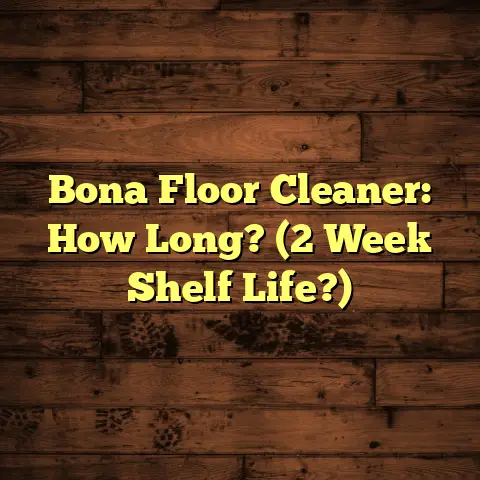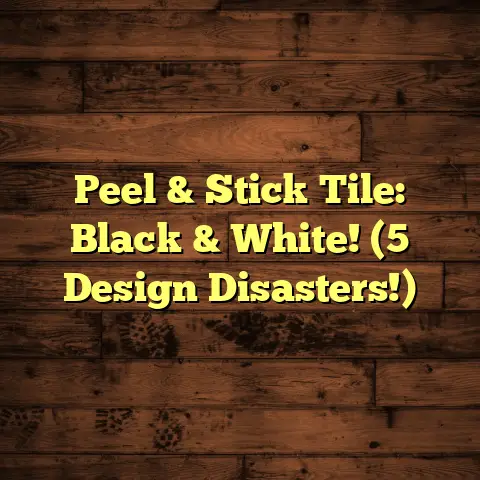Floor Underlayment Purpose? (1 Reason, Now!)
A clean, well-kept home starts from the ground up, right? I’ve seen it all in my years as a flooring contractor, and I can tell you, the secret to truly easy floor maintenance isn’t just about the top layer. It’s about what’s underneath: the floor underlayment.
Think of underlayment as the unsung hero of your flooring system. It’s that layer between your subfloor and your finished floor, and it plays a huge role in how your floors look, feel, and, most importantly, how easy they are to maintain.
Why am I so passionate about this? Because I’ve seen firsthand how much of a difference quality underlayment makes. Skipping it, or choosing the wrong type, can lead to headaches down the road – everything from noisy floors to moisture problems.
In this article, I’m going to break down the single, most important reason why you should always use floor underlayment: it makes your life easier by significantly enhancing the ease of maintenance. We’ll cover what underlayment is, the different types available, and how it contributes to a more comfortable and manageable home. Let’s dive in!
Section 1: Definition of Floor Underlayment
Okay, so what is floor underlayment, exactly? Simply put, it’s a layer of material installed between the subfloor (that’s the structural floor beneath) and your finished flooring (like laminate, hardwood, tile, or carpet).
Its purpose is to provide a smooth, stable, and often cushioned surface for the finished floor to rest on. The type of underlayment you need depends on the type of flooring you’re installing.
- Laminate: Typically requires a thin
foam or cork underlayment for sound
absorption and moisture protection. - Hardwood: Can use felt, cork, or
specialized foam underlayments to reduce
noise and provide a moisture barrier. - Tile: Often needs a cement board
underlayment to create a rigid, stable
surface. - Carpet: Usually installed over a
carpet pad, which acts as the
underlayment.
I’ve worked with countless materials over the years, and here are a few of the most common:
- Foam: Affordable and provides good
cushioning and sound absorption.
Often made from polyethylene or
polyurethane. - Cork: A natural, sustainable option
that offers excellent sound and thermal
insulation. - Rubber: Durable and provides
superior sound absorption and impact
resistance. Often used in commercial
settings or home gyms. - Cement Board: A rigid, water-resistant
material used under tile to provide a
stable base.
Each of these materials contributes to the overall performance of your flooring in different ways. They affect everything from how comfortable the floor feels underfoot to how well it resists moisture and noise.
Section 2: Enhancing Ease of Maintenance
Now, let’s get to the heart of the matter: how does underlayment make your life easier? As I said before, the primary reason I always recommend using underlayment is because it drastically enhances the ease of maintenance of your floors. Here’s how:
Subsection 2.1: Sound Absorption and Acoustics
Ever walked into a room and felt like the sound was just bouncing around? That’s often due to poor acoustics. Underlayment plays a significant role in reducing noise transmission, both within the room and to the rooms below.
Think about it: every footstep, every dropped object, every chair scraping across the floor creates noise. Without underlayment, that noise travels directly through the flooring and into the structure of your house.
A good underlayment, especially one made of foam, cork, or rubber, acts as a sound barrier, absorbing much of that impact noise. This creates a quieter, more peaceful environment.
But how does this relate to maintenance? Well, a quieter home is a less stressful home. You’re less likely to get annoyed by every little noise, which can actually impact how you care for your floors. Consider these points:
- Reduced Stress: Less noise means less
stress, which can lead to a more relaxed
and consistent cleaning routine. - Improved Focus: A quieter environment
makes it easier to concentrate on
cleaning tasks, leading to a more
thorough job. - Better Communication: You can actually
hear when something spills or needs
attention, preventing small messes from
becoming big problems.
Furthermore, the reduction in impact noise can actually extend the life of your flooring. Constant vibrations and impacts can loosen adhesives, cause cracks, and generally wear down the flooring material over time. By absorbing some of that energy, underlayment helps protect your investment.
I’ve seen this firsthand in apartment buildings. Units with underlayment tend to have fewer noise complaints and longer- lasting floors compared to those without. It’s a simple investment that pays off in peace and quiet.
Subsection 2.2: Moisture Barrier
Moisture is the enemy of flooring. Whether it’s from spills, humidity, or even a small leak, water can wreak havoc on your floors, leading to warping, mold growth, and costly repairs. This is where underlayment steps in as a hero.
Many underlayments, especially those designed for laminate and hardwood, incorporate a moisture barrier. This barrier prevents water from seeping through the flooring and into the subfloor, where it can cause serious damage.
Think of it like this: your flooring is the first line of defense against moisture, but the underlayment is the backup. It catches any spills or leaks that make it past the surface and prevents them from causing long-term problems.
Here’s how a moisture barrier in your underlayment simplifies floor maintenance:
- Spill Protection: Accidents happen.
With a moisture barrier, you have more
time to clean up spills before they
soak into the subfloor. - Humidity Control: In humid climates,
moisture can seep up from the subfloor
and cause warping or buckling. A
moisture barrier prevents this. - Mold Prevention: Mold thrives in
damp environments. By keeping the
subfloor dry, underlayment helps prevent
mold growth, which can be a major
health hazard.
I can’t tell you how many times I’ve seen floors ruined by water damage. It’s a heartbreaking (and expensive) experience. Investing in a quality underlayment with a moisture barrier is like buying insurance for your floors. It protects you from costly repairs and ensures that your floors stay looking their best for years to come.
For example, I once worked on a home where the homeowner had skipped the underlayment when installing laminate flooring in the basement. A small leak from a washing machine went unnoticed for a few days, and by the time they discovered it, the laminate had buckled and the subfloor was covered in mold. The cost to repair the damage was significantly higher than the cost of the underlayment they had skipped.
Subsection 2.3: Temperature Regulation
Did you know that underlayment can also help regulate the temperature of your floors? It’s true! Certain types of underlayment, like cork and some foam options, provide thermal insulation, helping to keep your floors warmer in the winter and cooler in the summer.
This might seem like a minor benefit, but it can actually have a significant impact on the overall comfort of your home and the longevity of your floors.
Here’s how temperature regulation through underlayment contributes to easier maintenance:
- Reduced Wear and Tear: Extreme
temperature fluctuations can cause
flooring materials to expand and
contract, leading to cracks, warping,
and other forms of damage. Underlayment
helps to buffer these temperature
changes, reducing stress on the flooring. - Energy Savings: By providing
insulation, underlayment can help to
reduce your energy bills, as your
heating and cooling systems don’t have
to work as hard to maintain a comfortable
temperature. - Improved Comfort: Let’s face it,
nobody likes walking on cold floors in
the winter. Underlayment makes your
floors more comfortable to walk on year-
round, which can make your home a more
enjoyable place to be.
Think about it: if your floors are constantly expanding and contracting due to temperature changes, they’re going to wear out much faster. This means you’ll have to repair or replace them sooner, which is a major maintenance headache.
I’ve seen this play out in older homes with poor insulation. The floors often show signs of wear and tear much faster than in newer homes with better insulation and underlayment.
Subsection 2.4: Leveling Uneven Surfaces
Subfloors are rarely perfectly level. Over time, they can develop dips, bumps, and other imperfections. Installing flooring directly over an uneven subfloor can lead to problems like:
- Uneven Wear: High spots will wear
down faster than low spots. - Cracking: Flooring can crack or break
if it’s not properly supported. - Squeaking: Uneven surfaces can cause
flooring to rub against the subfloor,
creating annoying squeaks.
Underlayment can help to level out minor imperfections in the subfloor, providing a smooth, even surface for the finished flooring. This is especially important for laminate and hardwood floors, which are more susceptible to damage from uneven surfaces.
Here’s how leveling uneven surfaces with underlayment simplifies maintenance:
- Reduced Wear and Tear: An even
surface distributes weight evenly,
reducing stress on the flooring and
preventing uneven wear. - Prevented Cracking: Underlayment
provides support and cushioning,
preventing cracks from forming in the
flooring. - Eliminated Squeaks: By filling in
gaps and providing a smooth surface,
underlayment can eliminate annoying
squeaks. - Easier Cleaning: A level floor is
simply easier to clean. There are no
dips or bumps to trap dirt and debris,
making vacuuming and mopping much more
efficient.
I’ve used self-leveling compounds to fix extremely uneven subfloors, but for minor imperfections, underlayment is a much simpler and more cost-effective solution. It can save you a lot of time and effort in the long run.
Subsection 2.5: Impact Resistance
Life happens. Things get dropped, furniture gets moved, and people walk (or even run!) across your floors. All of this impact can take a toll on your flooring, leading to dents, scratches, and other forms of damage.
Underlayment can help to absorb impact, protecting the surface of your flooring and reducing the need for repairs. This is especially important in high-traffic areas like hallways and living rooms.
Here’s how impact resistance through underlayment contributes to easier maintenance:
- Reduced Dents and Scratches:
Underlayment cushions the impact of
falling objects and foot traffic,
preventing dents and scratches from
forming on the flooring surface. - Extended Flooring Lifespan: By
protecting the flooring from damage,
underlayment helps to extend its
lifespan, saving you money on repairs
and replacements. - Lower Maintenance Costs: Less damage
means less need for repairs and
maintenance, which translates to lower
costs over time.
I’ve seen this firsthand in homes with young children. The floors in those homes tend to take a beating, but with a good underlayment, they can withstand a lot more wear and tear.
Think about it: a dropped toy, a spilled drink, a scuff from a shoe – all of these things can damage your floors. But with underlayment, you have an extra layer of protection that can help to minimize the impact.
Conclusion
So, there you have it. The single, most important reason to use floor underlayment is that it enhances the ease of maintenance. From reducing noise and protecting against moisture to regulating temperature, leveling uneven surfaces, and absorbing impact, underlayment plays a crucial role in keeping your floors looking their best and minimizing the amount of work required to maintain them.
Investing in quality underlayment is not just about making your floors look good; it’s about making your life easier. It’s about creating a comfortable, peaceful, and easy-to-maintain home environment that you can enjoy for years to come.
Don’t underestimate the power of this often- overlooked component. It’s the foundation for a beautiful and hassle-free flooring experience. Trust me, your floors (and your back!) will thank you.





